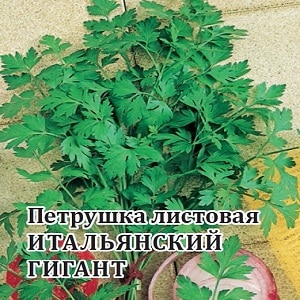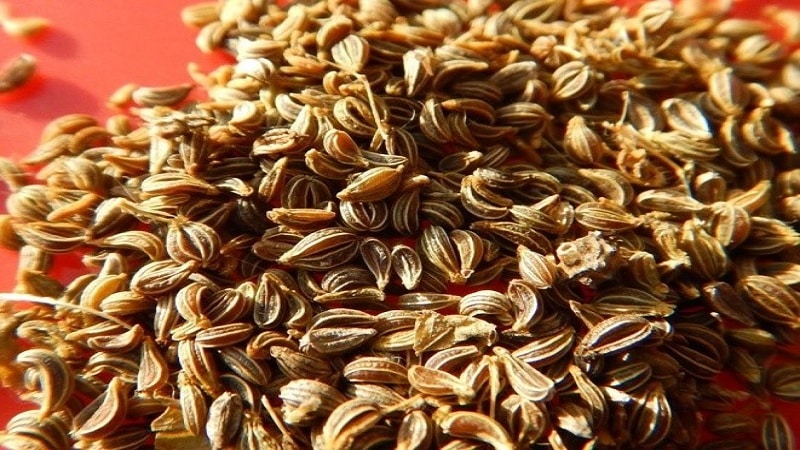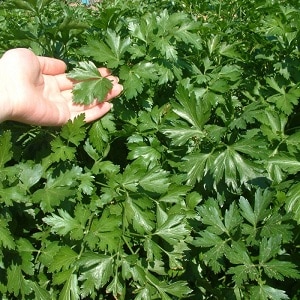Review of the parsley variety “Italian Giant”
The Italian giant is a smooth-leaved parsley of domestic selection. The crop is characterized by rapid growth of greenery after cutting, ease of care and the ability to sow three times a year - in spring, summer and late autumn. Aromatic greens with a tart taste are suitable for preparing meat, fish, and vegetable dishes. Parsley root is an indispensable component of vitamin-rich salads and first courses.
The article will tell you what kind of variety this is, how to grow it and how to protect it from pests and diseases.
Description and characteristics of the variety
The parsley variety Italian Giant was bred by breeders from Agrofirm Poisk and the Federal Scientific Center for Vegetable Growing. Culture was introduced into the State Register of Russia in 2007. The plant is suitable for cultivation in all regions of the country in private plots.
In the photo - Italian giant parsley.

The table shows the distinctive features of the variety.
| Indicators | Characteristics |
| Ripening period | Mid-season (90 days from germination to full ripeness) |
| Type | Sheet |
| Socket | Semi-vertical |
| Height | 67 cm |
| petiole | Medium length and thickness, with weakly expressed anthocyanin |
| Weight of greens per plant | 75 g |
| Aromaticity | Pronounced, tart |
| Taste | Excellent |
| Leaves | Juicy, tender, triangular in shape, green in color |
| Number of leaves on one plant | 20–25 |
| Application | Universal |
| Productivity | 2.8–5 kg per sq. m |
| Sustainability | To frosts down to -10°C |
Growing parsley
Gardeners prefer Italian giant parsley due to its high yield and ability to quickly grow greenery after cutting. The culture withstands bad weather and grows in shaded areas.
The plant's agricultural technology involves preparing seeds for sowing, loosening and weeding beds, thinning plantings, watering and fertilizing.
Seed preparation
Parsley seeds contain a large amount of essential oils, so they take a long time to germinate. Subject to the watering regime, sufficient humidity and soil temperature - after 15–20 days. In dry soil, the seeds “sit” without hatching for up to 30 days.
The following manipulations will help speed up germination:
- soaking in water at room temperature for 24 hours or in alcohol for 20 minutes, as alcohol dissolves essential oils;
- soaking in a pink solution of potassium permanganate, aloe juice or growth stimulants “Zircon”, “Heteroauxin”;
- drying the seeds on a paper towel or cotton cloth.
After such procedures, shoots will appear in a week.

Sowing dates
Sowing work begins in the spring. However, the unpretentiousness of the variety allows you to sow seeds in summer and autumn. To obtain an early harvest, seeds are sown before the start of winter.
Optimal sowing period:
- spring - end of April - beginning of May;
- summer - end of July;
- autumn - October and November.
Soil preparation
Beds for parsley are selected in a place protected from drafts, not swampy, and prepared in advance. The plant grows best in light, nutritious soil, where tomatoes, onions, and cucumbers previously grew.
The beds for spring sowing are prepared in the fall: they are dug up, plant debris is removed, loosened and fertilized with humus. In the spring, mineral compounds are added: urea, saltpeter, potassium and phosphorus.
Landing
The prepared seeds are planted in the furrows to a depth of 1.5 cm, with an interval of 8-10 cm. The distance between the furrows is 20-30 cm. Soil is poured on top and a layer of mulch is laid, for example, hay, straw.
To obtain a constant harvest until late autumn, they use the conveyor method - seeds are added every three weeks.
Care

Rules for caring for greens:
- Watering. The Italian giant does not tolerate excess or lack of moisture. Moderation is important here, otherwise the rhizome will rot from waterlogging. Water deficiency leads to stunted growth and wilting of greenery. In hot weather, water parsley once every 3-4 days; in rainy weather, refrain from watering.
- Loosening and weeding. Loosening is carried out as necessary, trying not to touch or expose the roots. The procedure improves soil aeration and retains moisture during dry periods. Weeds are removed with a hoe or by hand. The soil surface is mulched with hay or straw in a layer of up to 3 cm.
- Thinning. Manipulation is carried out as the parsley grows to ensure access to sunlight to young and weak shoots. Thinning improves the plant's nutrition with minerals and moisture.
- Feeding. Parsley is fertilized monthly with a solution of phosphates (5 g per 1 liter of clean water), if the soil was not fed with anything before planting. Otherwise, excess nutrients will provoke a rapid increase in green mass and cracking of the roots. An excess of nitrogen causes the growth of parsley, and a simultaneous loss of aroma and taste.
Diseases and pests
The Italian giant parsley variety has strong genetic immunity and, with proper care, successfully resists fungal diseases and insect attacks.
Prevention includes choosing a sunny area for planting, moderate watering, monitoring nitrogen in the soil and weeding weeds - the main carriers of fungal spores and parasites.
The main fungal diseases of parsley:
- Powdery mildew - a disease that appears in the form of a gray powdery coating on the leaves in late July - early August in warm and humid weather.
- Downy mildew (downy mildew) appears as yellow spots on the surface of the leaves and loose plaque on the back side. Subsequently, the foliage dries and falls off.
- White spot - dirty white spots with a brown outline on both sides of the leaf.
- Black rot — signs appear as the plant grows in the form of darkening and rotting of the root collar of the stem.
Preventive spraying with copper-containing products (copper sulfate, copper oxychloride) or the biological product “Fitosporin” will prevent infection of parsley by fungi.
To treat the plant, the following products and solutions are used:
- fungicides “Fundazim”, “Quadris”, “Skor”, “Bayleton”;
- 1 liter of curdled milk per 10 liters of water;
- 0.3 soda ash, 50 g of soap shavings per 1 liter of water;
- 1 liter of ash per 5 liters of boiling water;
- Boil 1 kg of horsetail and 10 liters of water for 2 hours, leave for 24 hours;
- 0.5 buckets of marigolds, 50 g of soap shavings per 10 liters of water.
Treatment with folk remedies is carried out once a week, with the exception of fermented milk solution, which has no restrictions in use.
Greens are only occasionally attacked by insects. The main pests of plantings: aphids, psyllids, stem nematodes. In order to prevent damage, the soil is spilled with a hot solution of potassium permanganate before sowing and crop rotation is maintained.
If insects are found on the stems and leaves of parsley, the preparations Fitoverm and Iskra Bio are used for spraying.Treatment is carried out 2-3 times every 7-10 days.
The safest folk remedies for insect repellents for human and plant health are:
- Leave 100 g of onion peels and 3 liters of warm water for 5 hours, dissolve 50 g of soap shavings;
- Leave 200 g of tobacco shag and 5 liters of water for 48 hours, strain;
- Leave 100 g of chamomile and 1 liter of water for 12 hours, increase the volume to 5 liters and add 25 g of liquid soap;
- Leave 1 kg of wood ash and 5 liters of water for two days, strain, dissolve 50 g of soap shavings;
- 2 tbsp. l. vinegar 9% per 3 liters of water;
- 1 tbsp. l. ammonia per 1 liter of water;
- 10 tbsp. l. soda per 10 liters of water;
- 100 ml milk, 15 drops of iodine per 1 liter of water.
Spraying is carried out in the evening to prevent sunburn on the leaves.
Features of growing the variety
The Italian giant produces young shoots from overwintered rhizomes. Such leaves are no less tasty than those grown from a seed. Gardeners often take advantage of this variety by harvesting a double harvest.
However, this method does not always give the expected result. The germination of greenery is prevented by:
- excess moisture in the soil;
- rotting of the rhizome;
- warm and wet winter;
- very coldy;
- lack of snow.
Mulching the area with sawdust, straw, and black agrofibre will help protect the root system from freezing.
Parsley is a biennial plant, so gardeners use this feature to grow greens in a perennial plot. This method of cultivating parsley is the simplest and most popular among gardeners. As the parsley grows, it fills the entire area, forming a “sea of green” and thereby preventing the growth of weeds.
When growing parsley on poor soils, fertilizing is applied as the plant grows and develops.The following fertilizers are used: nitrogen, potassium, phosphorus, wood ash, combined compounds.
Harvesting and application
In the first year of development, parsley forms a leaf rosette. Greens are cut throughout the growing season, following the rules:
- The inner leaves are left, cutting off only the top, so as not to limit the plant’s growth;
- leaves are taken from sprouts on which all three leaves have ripened;
- greens are cut at the root, providing space for the development of dense foliage.
Cut parsley is eaten immediately or frozen, and can also be preserved in jars for the winter.
In the second year, little foliage is formed in the rosettes. It can also be used for food, however, the main purpose is to obtain seeds from flower stalks for subsequent sowing. In the fall, parsley roots are dug up, which have a strong aroma and distinct taste. They are used in salads and added to soups, borscht and sauces.
Greens remain fresh for 12-15 days in the refrigerator at a temperature of 0...+5°C.
Parsley is widely used in cooking due to its unique property of enhancing the taste of foods and making them richer. Greens go well with chicken, game, fish, seafood, vegetables, cereals, and eggs. Pickling and pickling of cucumbers, tomatoes, eggplants, and zucchini is not complete without spicy herbs.
The healing properties of parsley have been known since ancient times. Infusions and decoctions of herbs are used to remove excess fluid from tissues, improve digestion, treat cystitis, relieve spasms, and eliminate itching from mosquito and midge bites.
The whitening properties of parsley juice make the plant indispensable in cosmetology. Freshly squeezed parsley juice is mixed with cucumber, onion, lemon juice and 1% vinegar. To thicken the mass, add whipped egg white. The mask is applied to cleansed skin face and hold for 15 minutes. The result is a gentle lightening of freckles and age spots.
Parsley seeds are used as a diaphoretic and diuretic for dropsy, swelling tissues, urolithiasis, menstrual irregularities, prostatitis.
Reference. 100 g of parsley contains 4 times more ascorbic acid than 100 g of lemon.
Advantages and disadvantages
Advantages of the variety:
- ease of care;
- rapid collection of green mass;
- frost resistance;
- resistance to fungal diseases and insect attacks;
- adaptability to unfavorable growing conditions;
- high productivity;
- sprouting greenery from roots.
Disadvantage: slow seed germination.
Read also:
How to distinguish cilantro from parsley.
When is it time to collect carrot seeds and how to do it correctly.
Reviews
Reviews about the Italian Giant variety are positive. The crop is valued for its productivity, strong aroma, pleasant taste and the possibility of almost year-round harvesting.
Vladislav, Voronezh: “I recently became acquainted with this variety of parsley. At first I thought that the plant came from Italy, but it turned out that domestic breeders were involved in the breeding. Greens grow on their own; the main thing is to fertilize the soil well before sowing. I water once a week, 3-4 times during drought.”
Olga, Chekhov: “I like this parsley primarily for its pronounced aroma and pleasant taste. The foliage is tender, not hard. Seeds are sown directly into the ground in spring, then in mid-summer and late autumn. The stems are tall and there are many leaves. We also use the root for food - I chop it and freeze it. Then I add it to soups and broths.”
Irina, Kursk: “Italian giant is my favorite parsley with an unmatched aroma and taste. Before sowing, I soak the seeds in Zircon and disinfect them in potassium permanganate. My plant is not sick with anything, even powdery mildew does not cling. I harvest the crop several times, freeze it and pickle it for the winter.”
Conclusion
The parsley variety Italian Giant has been highly appreciated by gardeners due to its undemanding nature in terms of growing conditions, high productivity, the possibility of year-round harvesting of herbs, and resistance to fungal diseases and pests. The crop is grown in perennial plots, collecting seeds and digging up roots in the second year.
Consumers like the distinct taste and aroma of parsley, the ability to use it in beauty recipes and prepare medicinal products at home.